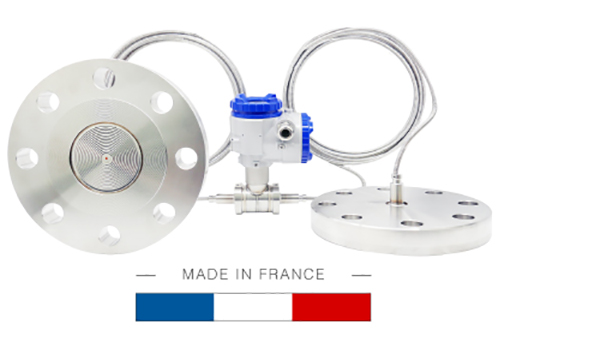Diaphragm seals pressure transmitter

Diaphragm seals pressure transmitter
Applications
- Level, flow, pressure, interface, density
- Extreme hot and cold temperatures
- Corrosive, clogging, or viscous processes
- Hygienic requirements
- Special process connections
A technology for manufacturing pressure sensors with custom-made diaphragm seals
High-tech industries such as chemical, oil and gas, pulp and paper, food and beverage put their measuring devices to the test.
Manufacturing processes require pressure sensors with high accuracy and reliability.
The reduction of manufacturing costs requires avoiding rejects and production stoppages.
The obsolescence of some measuring devices requires finding replacement instruments that can fit in place.
When your need is specific and no conventional equipment fits the particularities of your installation, we build a custom seal sensor.
Construction
Seals are used with differential, gauge or absolute pressure sensors.
They can be mounted rigidly, directly on the sensor or with a capillary tube that connects the seal to the transmitter.
The seal and the sensor are welded together without any gaskets, and then filled with an oil suitable for the application.
Measuring principle of diaphragm seals pressure sensors
- In some chemical or hygienic applications, it is necessary to isolate the measuring instrument from the process medium pressure.
- The diaphragm seal serves as a protective interface between the measuring cell and the process medium.
- The diaphragm and the contacting parts are made of a material resistant to the process medium and welded to the base of the measuring cell.
- A capillary tube or a connecting sleeve provides the connection between the seal membrane and the sensor measuring cell.
- This space must be degassed under vacuum and then filled with a suitable oil filler and sealed.
- The measured pressure exerts a force on the outer surface of the membrane.
- As the diaphragm flexes inward, it attempts to compress the filling fluid inside the instrument.
- This filling fluid is designed to resist compression, so the force is channeled directly to the measuring cell.
- The entire operation of the diaphragm pressure sensor is based on Pascal's principle.
- This principle states that a pressure exerted on a fluid is transmitted without loss through the fluid in all directions.
- For this process to work, the displacement force of the diaphragm must be greater than the force required to move the sensing element in the measuring cell.
- In practice, this means that the smaller the force required to move the sensing element, the easier it is to build an accurate sealing system.